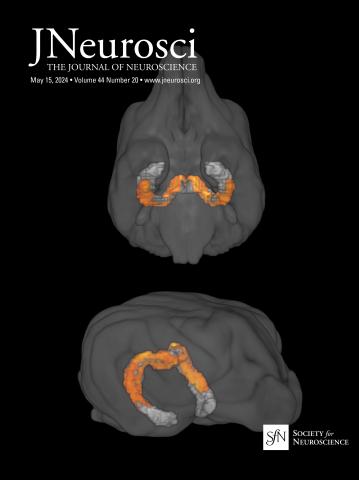刺激包络对运动与声音同步的复杂影响。
IF 4.4
2区 医学
Q1 NEUROSCIENCES
引用次数: 0
摘要
人脑忠实地追踪声信号的时间规律。最近的神经影像学研究表明,同步神经活动对刺激包膜的形状有复杂的调节。如何将神经对不同包络形状的反应与听者对声音节奏同步的感知能力联系起来,需要进一步的表征。在这里,我们研究了人类参与者(14名女性,10名男性)对周期性振幅调节(AM)的噪声刺激的运动和感觉同步。我们使用了三种包络形状,它们在振幅开始的锐度上有所不同。在一个同步运动手指敲击任务中,我们发现参与者在听到突然开始的刺激时比听到逐渐开始的刺激时更一致地将他们的敲击对准刺激包络的同一阶段。这种效应在感觉同步任务中得到了复制,这表明对突发刺激的加速相位对齐存在感觉基础。令人惊讶的是,尽管与渐起刺激的包络不一致的轻拍对齐,参与者在从急剧和渐起刺激中提取振幅调制速率方面同样有效,并且他们在声音输入时始终以该速率轻拍。这一结果表明,在不存在尖锐的声学边缘或与刺激包络一致的相位对准的情况下,可以实现声周期性率的鲁棒跟踪。我们的研究结果与假设在感觉运动同步过程中相位和速率跟踪的不同过程是一致的。这些过程很可能是由不同的神经机制支撑的,这些机制的相对强度是由刺激包络特征的特定时间动态调节的。大量证据表明,同步的神经生理活动与声音的时间规律有关。这一现象被认为反映了声学信号中对起始边缘的神经反应。在这里,我们检查听者的能力,行为同步刺激与突然或渐进的开始。在两个实验中,我们发现,虽然急剧振幅启动促进了参与者的行为输出和刺激包络之间的时间相位对齐,但急剧启动对于跟踪声音输入中的听觉节奏速率并不是必需的。相位和速率跟踪之间的分离表明不同的潜在神经机制是分开调节的。本文章由计算机程序翻译,如有差异,请以英文原文为准。
Complex impact of stimulus envelope on motor synchronization to sound.
The human brain tracks temporal regularities in acoustic signals faithfully. Recent neuroimaging studies have shown complex modulations of synchronized neural activities to the shape of stimulus envelopes. How to connect neural responses to different envelope shapes with listeners' perceptual ability to synchronize to acoustic rhythms requires further characterization. Here, we examine motor and sensory synchronization to noise stimuli with periodic amplitude modulations (AM) in human participants (14 females, 10 males). We used three envelope shapes that varied in the sharpness of amplitude onset. In a synchronous motor finger-tapping task, we show that participants more consistently align their taps to the same phase of stimulus envelope when listening to stimuli with sharp onsets than to those with gradual onsets. This effect is replicated in a sensory synchronization task, suggesting a sensory basis for the facilitated phase alignment to sharp-onset stimuli. Surprisingly, despite less consistent tap alignments to the envelope of gradual-onset stimuli, participants are equally effective in extracting the rate of amplitude modulation from both sharp and gradual-onset stimuli, and they tapped consistently at that rate alongside the acoustic input. This result demonstrates that robust tracking of the rate of acoustic periodicity is achievable without the presence of sharp acoustic edges or consistent phase alignment to stimulus envelope. Our findings are consistent with assuming distinct processes for phase and rate tracking during sensorimotor synchronization. These processes are most likely underpinned by different neural mechanisms whose relative strengths are modulated by specific temporal dynamics of stimulus envelope characteristics.Significance Statement Ample evidence demonstrates synchronized neurophysiological activity to the temporal regularities of sounds. This phenomenon has been proposed to reflect neural responses to onset edges in acoustic signals. Here, we examine listeners' ability to behaviorally synchronize to stimuli with sharp or gradual onsets. In two experiments, we show that while the sharp amplitude onsets facilitate temporal phase alignment between participants' behavioral output and the stimulus envelope, sharp onsets are not essential for tracking the rate of auditory rhythms in the acoustic input. The dissociation between phase and rate tracking suggests distinct underlying neural mechanisms that are separately modulated.
求助全文
通过发布文献求助,成功后即可免费获取论文全文。
去求助
来源期刊

Journal of Neuroscience
医学-神经科学
CiteScore
9.30
自引率
3.80%
发文量
1164
审稿时长
12 months
期刊介绍:
JNeurosci (ISSN 0270-6474) is an official journal of the Society for Neuroscience. It is published weekly by the Society, fifty weeks a year, one volume a year. JNeurosci publishes papers on a broad range of topics of general interest to those working on the nervous system. Authors now have an Open Choice option for their published articles
 求助内容:
求助内容: 应助结果提醒方式:
应助结果提醒方式:


